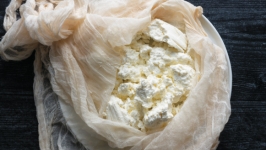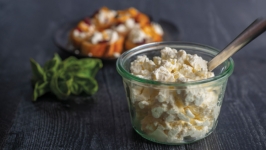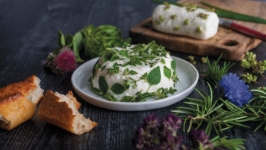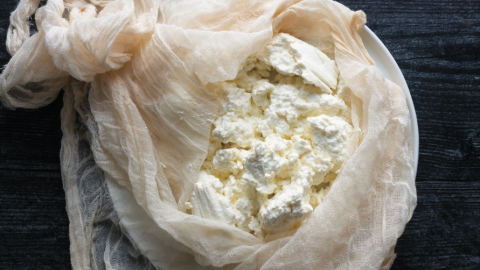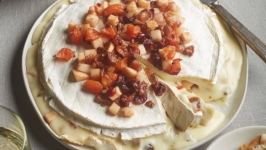How to Make Cheese At Home: Start with Simple Fresh Cheeses
A couple of years ago, I was given the opportunity to milk goats. Prior to this I knew very little about milking other than it would mean we would have a fresh supply of goat milk in our fridge. Being on a constant quest to find local food and learn where the food comes from that I feed my family, this seemed like a natural course of direction. What I did not take into account was the amount of milk I would be regularly receiving. This abundance led me into making weekly batches of yogurt and then into making simple, fresh goat cheeses.
Until this time, I’d never thought of moving beyond making my usual “yogurt cheese” (straining salted yogurt-get recipe here). The thought of making cheese had always seemed daunting. I was afraid I would need to add more tools to our already abundant kitchen. After a bit of research, I realized we already had all of the tools and ingredients—an instant-read pan thermometer, cheesecloth, goat milk, vinegar and salt. Voilá—my first fresh goat cheese! To my surprise, it was quite simple to do and delicious—especially with the addition of fresh chives and herbs from our garden.
![]() Even with that success I hesitated to venture further until I came across Morgan McGlynn’s recently released book The Modern Cheesemaker: Making and Cooking with Cheeses at Home. Morgan, who at age 21 was named Britain’s youngest female cheesemonger, is also the owner of the award-winning cheese shop Cheeses of Muswell Hill in North London. She takes her years of experience and transforms them into clear, step-by-step instructions that are supplemented with beautiful photography. There are variables in cheesemaking (such as type of milk or rennet used) so the simplicity of her directions makes the process less overwhelming. Once you have success in making cheese, you might find that you have a surplus on hand. Not to worry, the book is also full of fresh, seasonal and delicious ways to incorporate it into your meals.
Even with that success I hesitated to venture further until I came across Morgan McGlynn’s recently released book The Modern Cheesemaker: Making and Cooking with Cheeses at Home. Morgan, who at age 21 was named Britain’s youngest female cheesemonger, is also the owner of the award-winning cheese shop Cheeses of Muswell Hill in North London. She takes her years of experience and transforms them into clear, step-by-step instructions that are supplemented with beautiful photography. There are variables in cheesemaking (such as type of milk or rennet used) so the simplicity of her directions makes the process less overwhelming. Once you have success in making cheese, you might find that you have a surplus on hand. Not to worry, the book is also full of fresh, seasonal and delicious ways to incorporate it into your meals.
Simple, fresh cheeses are where to start. Not only are these cheeses quick to make, they are super versatile for adding your favorite seasonal herbs, spices and edible flowers. They look and taste “whey cool.”
Before You Begin
As we reviewed The Modern Cheesemaker book and tested recipes, we discovered a few basic things you'll want to know for cheesemaking at home.
• Cheese salt is non-iodized. Iodized salt harms and inhibits bacterial growth that is essential to any good cheesemaking.
• Rennet is the enzyme ingredient you add in to coagulate the milk and create curds. Rennet quantities and directions will vary depending on what kind of rennet you use. There are different types of rennet, the most common are animal and vegetable rennets. It is important to follow the instructions that come with your specific rennet for the quantity of milk you are using. We tested The Modern Cheesemaker recipes with animal rennet and diluted ⅛ teaspoon (5–6 drops) in ⅛ cup of non-chlorinated water before adding the entire dilution to the milk.
• Use a non-reactive pot and stirring utensil. And a pan thermometer with long probe is a must.
• Raw milk works best. Ultra pasteurized milk will not work.
• Want a drier cheese? Let it hang longer. Humidity and climate can affect drying time.
• Tying your hanging bag to drain the whey (the watery part of milk that remains after the formation of curds) from the cheese curds can be tricky the first time. Check out the cheesecloth and cheese bag tying and draining tips reprinted from the The Modern Cheesemaker book here.
Making Your First Cheeses
All cheesemaking recipes rely on a few important steps:
Step 1: Assemble your ingredients and tools
Step 2: Heat your cheese mixture–milk, rennet or citric acid, plus recipe ingredients to coagulate curds and create a gel mixture
Step 2A: (not shown) Gently cut up or cube the curd mixture while still in the pan to help separate the curds and the whey ( the watery part of milk that remains after the formation of curds.)
Step 3: Place curd mixture into a cheesecloth lined bag to prepare for tying a draining bag.
Step 4: Tie bag, and drain curds from whey using a hanging cheesecloth cheese bag. Tips on tying a cheese bag here.
Step 5: Salt, flavor and prepare cheese according to recipe.
